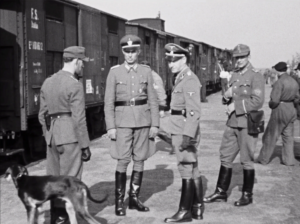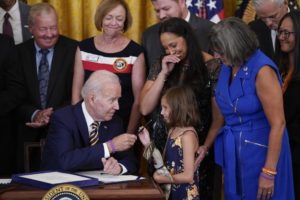HARBOR SPRINGS, Mich. (WOOD) — The discovery of unmarked mass graves at Indigenous boarding schools in Canada is sparking fears similar discoveries could be made in Michigan.
The same types of boarding schools that existed in Canada were also in the United States. Michigan was home to the longest-running one in the nation. Located in the resort town of Harbor Springs in the northern Lower Peninsula, it didn’t close until the 1980s.
Tribes say such boarding schools contributed to the genocide of Native Americans.
Harbor Springs hosts summer homes for the wealthy. Well-manicured lawns line the view of the bay. Downtown is filled with shops, art galleries and restaurants. At the end of Main Street is Holy Childhood of Jesus Catholic Church.
The native children who attended the boarding school linked to that church called it Unholy Childhood.
“Children did die here,” said Kateri Walker, who was a student at the school when she was a child.
The history is hidden in plain sight. Only one entrance and a classroom were negotiated to remain of boarding school when it was torn down.
“If I didn’t tell you, you wouldn’t know,” Walker said. “You would go, ‘Oh, why is that brick there?’ Each of these bricks stands for a child.”
Walker is one of an estimated tens or perhaps hundreds of thousands of children who attended native boarding schools that were primarily run by religious organizations and overseen by Washington. The federal government took over the schools in the late 1800s with the motto “kill the Indian, save the man.”
“Everyone in America can be who they want to be, but we’re (Native Americans) not allowed to be who we are,” Walker said. “There’s a manual how to break our spirit. There’s an actual school manual that exists.”
Walker was 6 years old when she was brought to Holy Childhood Boarding School by her mom. Other children were taken from their homes in the middle of the night. Some families taught their children hide and seek to avoid being taken away.
The idea behind the boarding schools was to remove America’s so-called “Indian threat” by taking the next generation, ending their cultural practices, forcing them to speak English and cutting their hair, which in Native American culture holds memories.
The only boarding school still standing in Michigan is the Indian Industrial Boarding School in Mt. Pleasant. Roughly 300 students attended every year. Two others — the Holy Name of Jesus Indian Mission in the Upper Peninsula and Holy Childhood in Harbor Springs — have been torn down.
But Walker remembers.
“It’s scary. I used to get migraines talking about it,” she said. “I used to think as a 6-year-old, ‘I’m going to tell,’ and here I sit as an adult and I’m speaking and I’m telling.”
The schools were set up like a prison, she said.
“We didn’t have names, we had numbers,” explained Walker “My number was 2 my first year.”
The days filled with school, chores and church. And abuse, Walker said: physical, emotional and sexual.
“Orgies happened in the basement…” she said.
According to historical accounts, boys were the main target of sexual abuse by nuns, but everyone was fair game for beatings.
“When you heard the nun’s footsteps coming on the wood and you saw those shadows in the big windows, you would go, ‘Sister’s coming, Sister’s coming,’ so everyone would clean and run. You didn’t want to be near the door because when she came in swinging, she would hit whoever was there,” Walker said.
Children were kept away from their families for months, sometimes years. If they told their family about the abuse, it would get worse.
Walker recalls being punished for hugging her mom for too long at the end of a visit when she was 9.
And parents were denied visits. A letter shared by the Saginaw Chippewa Tribe shows a mother pleading to see her child: “I want to know if I can get my little daughter home for vacation…. I sometimes get lonesome for her.”
While Walker, now 57, said the school was a traumatizing and humiliating experience, she still considers herself one of the lucky ones. She was able to leave the boarding school in 1977 when she was 12. She went on to graduate from the University of Michigan and pursue acting in Hollywood. She said her success allowed her to avoid suicide and addiction that many of her classmates succumbed to.
“My tears are for those people that didn’t get to have innocence,” Walker said, breaking down. “They didn’t get to have laughter. They don’t know love.”
The National Native American Boarding School Healing Coalition is asking former students to share their experiences, like Walker. You can contribute to the registry online. Those who are struggling with thoughts of suicide or addiction can find resources through the board.
FINDING THE CHILDREN
The recent discovery of the unmarked mass graves in Canada is sparking renewed efforts to find the students who never came home from the schools in Michigan.
Some 215 bodies were discovered at a Canadian boarding school in May, more than 750 graves in June and then 182 more bodies.
The United States has yet to look for graves at its schools. Tribal members want to start searching.
“We just want the proper justice for our young ones that were taken from us,” said James Bud Day, the cultural director for the Match-E-Be-Nash-She-Wish Band of Pottawatomi Indians, more commonly known as the Gun Lake Tribe.
Tribes say hundreds of students passed through Michigan’s three Indigenous boarding schools each year for more than 80 years; some students never left. Day said he has heard firsthand accounts of people burying bodies at the school grounds.
“One of his responsibilities and jobs at the boarding school was to bury the babies,” he said.
Day has also seen an incinerator at one school in Michigan, which leads him and others to believe that some of the children’s bodies may have been burned. But Day and other tribal members believe if old school grounds are searched, there will be bodies.
“Just going by the odds alone, there has to be,” he said. “That’s why us as native communities we want those investigations done.”
In 1997, Holy Childhood moved student remains found on the property to Holy Childhood of Jesus cemetery in Harbor Springs. A single white cross was put up on the old school property in their honor.
Still, tribe members believe there are more remains scattered on the property. Target 8 asked the Catholic Diocese of Gaylord, which ran the school, for the death records, but was told they could not be found.
“There’s probably native people laying here now as we speak,” Walker said.
HOW MANY ARE DEAD?
In Mt. Pleasant, boarding school records show five documented deaths, but research by Central Michigan University Professor Sarah Surface-Evans found at least 227 children died there, calling into question the validity of the school records that exist. What the CMU professor couldn’t find is where the bodies were laid to rest in Mt. Pleasant.
Historic records list students as between the ages of 5 and 14, but photos indicate some may have started younger and left later.
Unsanitary conditions and overcrowding fueled communicable diseases like smallpox, especially in students weakened by trauma and small food rations. Some died from disease, others suicide or even beatings. Schools had their own cemeteries and students often built their classmates’ coffins, according to tribal records.
“Who could do that to a child? And Americans say, ‘Well that’s not me who did that. Well, that was a long time ago; it wasn’t me,’” Walker said.
Target 8 requested on-camera interviews with the Catholic dioceses that ran the schools, but they declined, saying the schools were open too long ago and they didn’t feel comfortable commenting. Some officials did talk off-camera and provided information.
“They know where the bodies are. They know where the records are,” Walker said of the church. “It’s kind of scary to say this because they could be shredding documents right now, as we speak.”
Still unknown to tribal members is how many Native American children died or went missing from the boarding schools.
“It is the state’s responsibility” to find that out, Walker said.US to review dark history of Indigenous boarding schools
She and other tribal members, along with the National Native American Boarding School Healing Association, say the least the state and or federal government can do is help find the children.
When Target 8 asked whether any searches were planned, Gov. Gretchen Whitmer’s office did not immediately have any comment.
Some tribal members say that if the government won’t step up, the tribes will do it themselves.
“We want that justice for them,” Day said. “We want that healing for those families, whether it was generation ago or not. We want their spirits to be set free.”




